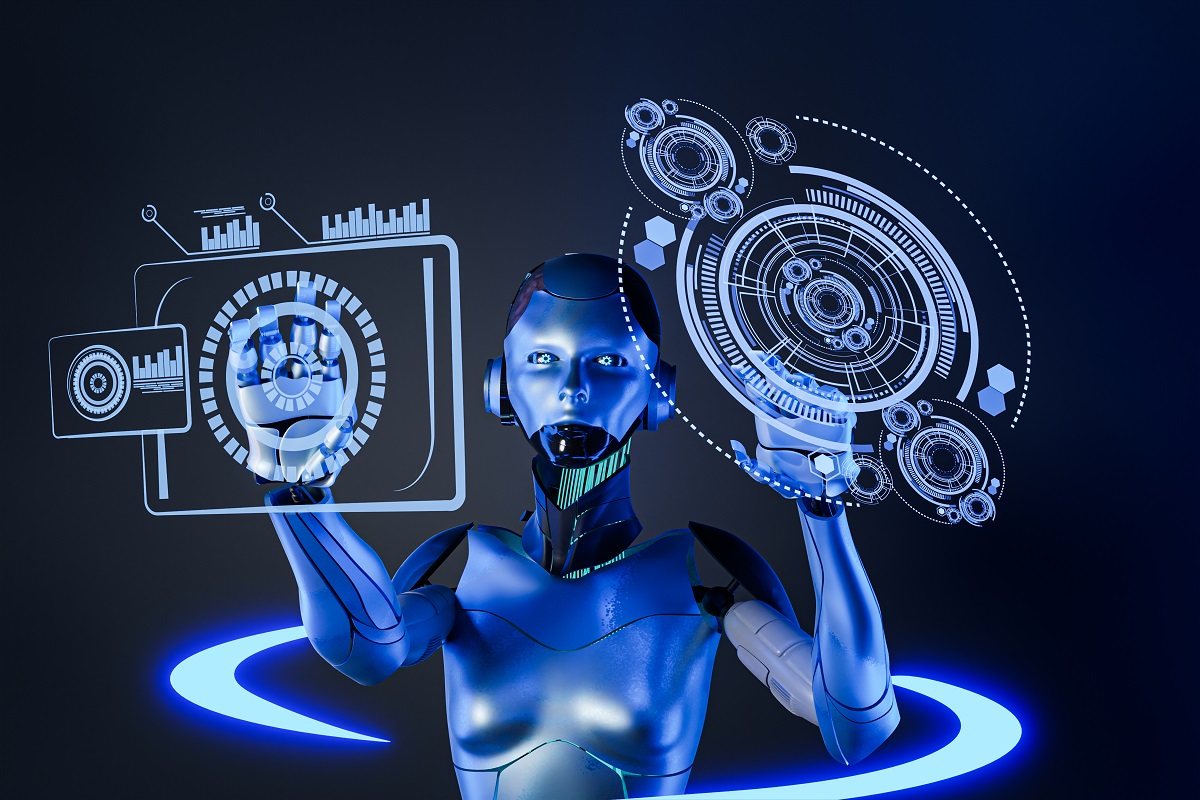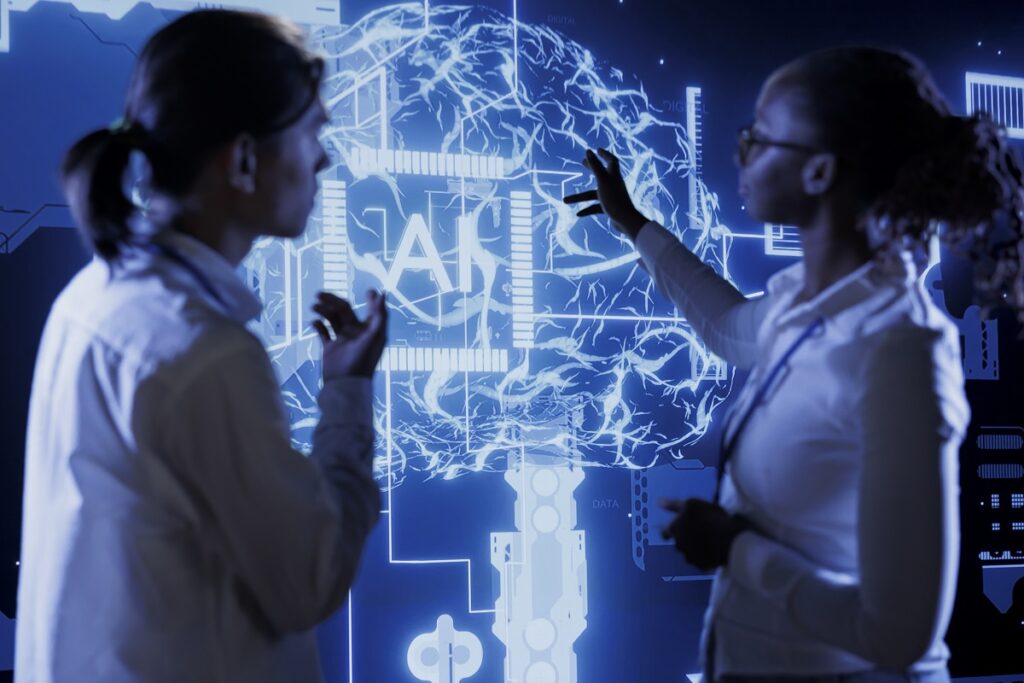The entire world is flooded with lots of information and data. Videos, images or spreadsheets, audio, and even text created by humans and computers are obliterating the Internet and submerging us in the vast ocean of information. In the past, human beings looked at data to make educated decisions. They were able to adjust systems to manage the shifts in data patterns.
However, as the amount of data we receive increases, our brain’s capacity to comprehend it diminishes. This leaves us with a dilemma: how can we use the vast amount of data available to find its meaning in an automated method rather than a manual one? This is precisely the point where machine learning is brought into the equation.
Machine learning models aid businesses in gaining valuable insight efficiently using data. The services for developing machine learning let companies today access data to teach systems how to correct issues using ML algorithms. Utilizing machine learning and other techniques in the business world aids in improving profitability and driving the business decision-making process based on companies specializing in custom software development. The machine learning tools and platforms also integrate algorithms with data to find critical business information and deploy new strategies.
In this thorough guide, we’ll explore the features, and steps required for machine learning development.
Understanding Machine Learning
Machine learning is an exclusive process of developing algorithms that can utilize data as an input to forecast new output values. It generally displays human-like abilities and allows enterprises to examine customer behavior patterns, new product developments, and operating patterns within the business. Machine learning is now one of the significant advantages of various companies.
Machine learning aims to create algorithms that can automatically assist a system in collecting data and then using this data to discover more. The system is expected to search for patterns within the data it gathers and utilize these patterns to make crucial decisions independently. Machine learning, in general, can help systems behave and think like human beings, show the human kind of intelligence, and provide them with a brain.
However, despite its promise, ML development requires a strong knowledge of statistics and math. Training ML algorithms demands a large amount of top-quality data for exact results. Particularly, the outputs from complex models such as deep neural networks may present challenges when it comes to interpretation. Furthermore, deploying or fine-tuning ML models could be a time-consuming process.
However, the incorporation of ML into IT and business strategy has become more commonplace, enabling businesses to simplify processes, anticipate developments, and limit risk. With the advancement of machine learning, it is expected to increase the efficiency of problem-solving and task automation across a range of areas.
How Does Machine Learning Work?
Machine learning is widely used across various industries. It has an extensive array of real-world applications that involve analyzing, collecting, and analyzing enormous datasets. ML allows machines to learn from past data and make predictions. Machine learning generally involves patterns and data exploration akin to human input. Two methods that are popular for machine learning are listed below:
Supervised Learning
Supervised learning is a popular method of machine learning that requires supervision. The ML algorithms take in a set of inputs and the corresponding outputs. When deciding the model’s precision, the algorithms evaluate their expected outputs against the proper outputs. Supervised machine learning is based on patterns that predict the value.
With the supervised learning method, the machine has been well-trained by using labeled data, which implies that data is labeled with proper outputs. Additionally, it’s identified by using a labeled data set to allow the training of algorithms that accurately classify the data and anticipate the outcomes. It helps companies tackle various real-world issues, such as categorizing spam into a brand new folder to separate it from the existing one.
Unsupervised Learning
Unsupervised machine learning never needs properly labeled or classified data when creating a model for the machine. This method is where machines cannot determine the hidden structure.
Additionally, unsupervised models for learning are used in three primary tasks: clustering, association, and dimensionality reduction. Unsupervised learning is based on two different algorithms: Clustering and association. Unsupervised learning is extensively employed for more complex tasks than supervised learning because it doesn’t require specific data to be labeled.
Key Features Of Machine learning
Machine learning is now one of the most enormous technological advances in the last few years, significantly affecting the entire spectrum of fields. Its primary features include:
Capability To Automate Data Visualization
An enormous amount of information is generated by companies and everyday citizens every day. By visualizing the relationships that are evident in the data, companies can make more informed choices and build trust.
Machine learning is a set of instruments that can provide powerful fragments of information that can be used to analyze both unstructured and structured data types. Utilizing the user-friendly, automated data visualization systems that use machine learning, companies can get various fresh insights to improve the effectiveness of their operations.
Customer Engagement Like Never Before
A business’s one of the primary strategies to boost customer engagement, build the brand’s loyalty, and build trusting relationships with its customers for a long time is initiating meaningful conversations with their targeted customer base. Machine learning is essential in helping businesses and companies create deeper conversations with customers regarding customer engagement. It analyzes specific phrases such as words, sentence phrases, and formats of content that are popular with particular people.
Automation At Its Finest
One of the most significant features of machine learning is its ability to streamline repetitive tasks, improving efficiency. Numerous companies are using machine learning-powered paperwork and automated email. For example, many routine, heavy data, and predetermined tasks must be completed in finance, which is why this sector extensively uses different machine learning tools. These solutions make accounting processes quicker, more efficient, and more accurate.
Increase Efficiency When Merged IoT
Because of the great media hype about the IoT machine learning field, it has seen massive growth in popularization. IoT is now being regarded as necessary strategically by numerous firms. In addition, many companies have started trials to test the benefits of IoT within the context of their business processes.
Yet, making financial gains by using IoT isn’t a simple task. Successful firms that offer IoT consultancy services and platforms should be clear about what areas will be affected as they implement IoT strategies. Most of these companies aren’t able to tackle the issue. Machine learning could be the most effective technique that could be utilized to increase effectiveness. Companies can improve efficiency across their production process by combining machine learning and IoT.
Accurate Data Analysis
The traditional approach to data analysis has always relied on trial and error, which becomes impossible when dealing with huge and diverse data sets. Machine learning is ideal for all problems because it provides effective data analysis methods. Machine learning can produce accurate results and analysis by developing efficient and speedy algorithms and model-driven data for processing information in real time.
Best Of Business Intelligence
When coupled with considerable data-based analytical work, machine learning’s characteristics could result in extreme degrees of business intelligence, which different sectors can use to implement strategic decisions. From financial services to retail to healthcare and many other areas, machine learning is already one of the best techniques to enhance business operations.
It doesn’t matter if you believe it or not; these traits that machine learning has played significantly have made it one of the major technological trends, which are the basis of a vast variety of products we utilize today without being aware of the implications.
Types Of Machine Learning Development Services
The usage of AI/ML applications at both macro and micro levels is proliferating. Nowadays, companies are beginning to harness the value of data to improve processes, increase the customer experience, and reduce expenses.
Machine learning services can help businesses predict users’ behavior more accurately and help to upsell and improve processes. Services for developing machine learning change how industries operate, such as healthcare, fintech, education, e-commerce, social service, and many others. These are the services provided by trusted machine learning companies:
Deep Learning Solutions
Deep learning models are a prevalent method of machine learning that aids in the development of the framework for business technology. It learns and improves features automatically by studying algorithms. Deep learning algorithms can provide the latest standards of accuracy and sometimes surpass the human level of capabilities.
Predictive Analytics
Predictive analytics is a component of advanced analytics that uses statistical models, descriptive analytics, and large volumes of data. It forecasts future outcomes using historical data and is then augmented by data mining methods, including statistical modeling and machine learning.
The company that develops machine learning uses predictive analytics to identify patterns in data that can be used to identify potential risks. Additionally, they assist businesses in evaluating accurate information using machine learning and statistical algorithms.
Machine Learning Programming
Machine learning experts specialize in developing specific software designed to streamline the business process and create effective decision models. With machine learning programming, they can transform raw data into big datasets through clustering and regression models and classify across different systems. Additionally, predictive models can help improve business performance, protect against risk, and aid clients in gaining insight into their business.
Marketing Automation Solutions
Marketing automation can be described as automating, measuring, and streamlining marketing workflows and processes to increase operational efficiency. The tools for marketing automation give you greater insight into potential customer behavior.
By integrating ML programs into CRM software and marketing automation, marketers can break down the complete market segmentation process, improve lead forecasting, calculate leads, implement precise marketing strategies, and increase content recommendations to specific clients and market segments.
Neural Network Development
Neural networks, often called artificial neural networks or simulated neural networks, are part of machine learning. They can assist marketers in predicting campaign results by recognizing patterns in previous advertising campaigns.
By developing neural networks, developers can easily handle large sets of data using many variables. Neural networks are also utilized in various business applications, including pattern recognition, sequence recognition, and decision-making.
Machine Learning Applications For Enterprises
In this section, we will explore the top machine learning applications for businesses and enterprises.
Business Analytics
Machine learning empowers companies to sort through vast volumes of data to uncover clues that can be used to make efficient decisions. By identifying patterns, ML assists in determining strategies and enhances the efficiency of operations, helping companies remain ahead of their competitors.
CRM (Customer Relationship Management)
ML transforms the way businesses interact with their customers by anticipating behavior, customizing interactions, and fine-tuning marketing strategies. Companies can build stronger relationships by separating customers into segments and delivering specific solutions, ultimately boosting their profits.
Security Protocol And Adherence To Regulations
ML increases security by identifying problems and monitoring transactions to verify compliance with the rules. With the help of cutting-edge technology, businesses can more efficiently protect vulnerable data from cyber-attacks.
HRIS (Human Resource Information Systems)
ML reduces the complexity of recruitment, talent scouting tests, and maintaining the best talent. By examining candidates’ profiles and anticipating job suitability, companies can simplify the recruitment process and create an engaged workforce.
Smooth Flow Of Goods
In the world of logistics for supply chains, ML transforms the way that inventory management is handled, forecasts demand, and refines logistical operations. Companies increase efficiency and reduce expenditures through process automation and proactive dealing with disruptions.
Technology For Processing Languages
ML is an interface for smooth exchange across various languages, helping to facilitate efficient global operations. Natural language processing software allows companies to efficiently reach out to a variety of audiences and increase their market reach.
Machine Learning Development Process
The machine learning development process is a complex one. It requires a mix of perseverance, creativity, and the ability to experiment. It is possible to simplify creating, deploying, and managing ML models by following a common structure. Understanding the process helps in understanding the processes of developing ML models. It enhances your understanding of the most effective practices for guiding your project toward completion.
Assessment Of Goals And Project Planning
The first stage of an ML development is the planning process, which aids in assessing the possible scope, feasibility, and success indicators of the machine-learning applications. It is equally crucial to know how the ML method could solve issues faced by a company. Planning allows you to consider ways to leverage machine learning to enhance your current processes.
Cost-benefit evaluation is another crucial aspect to consider during the planning stage in the ML development process. Also, you must set a timetable to deliver the ML solution over various stages. Additionally, it would help if you offered measurable, practical measurements for the ML model and business and economic indicators.
Additionally, the planning process demands the development of a feasibility study. The feasibility report needs to contain information on access to data and legal restrictions, as well as explanations of application, resilience, and the possibility of scaling. It is also necessary to include details regarding the available resources for your project in your feasibility report.
Identify The Type Of Data Required For The Project
The case business for a machine learning program will help establish a structure that will guide the design of the subsequent steps for the undertaking. Data is the mainstay of projects involving machine learning. The development procedure begins with the identification of data requirements. ML models gather generalized information about the data they have trained on and use the insights gained through training to make fresh predictions.
The main factors to consider when deciding on the requirements for data include the nature and amount of data available, the high-quality training data, and the sources of data. Additionally, you should know whether you could use a machine-learning model to ensure you’ve made the best decision. The procedure for determining required data for a machine-learning project includes understanding how the model could operate with actual-world information.
Preparing The Data For Your ML Projects
Please pay particular attention to data preparation in ML projects because it affects how your machine-learning model can be acquired. The development of machine learning is heavily influenced by the four main pillars of data preparation, which include the collection of data and its labeling, cleaning, processing, and administration. Below are a few essential steps you need to adhere to when preparing data for ML research projects.
Data Collection And Labelling
Developers should determine the best way to collect information by finding the most suitable data sources. A few of the most well-known data sources include vendor data, internal data, synthetic data generation, and open-source platforms. Different data sources have particular strengths and drawbacks. Some projects might need all the sources. Once you have collected the information, mark it with a label to allow for changes throughout the development lifecycle. Labeling and collecting data is a lengthy and time-consuming process requiring much of your company’s resources.
Data Cleaning
Refinement or cleaning of data is a different highlight of responses to “How is machine learning developed?” during the data preparation phase. This involves putting in missing data and reducing noise. It also involves removing any outliers and analyzing information with incorrect classifications. It is also possible to build data pipelines that allow for the automation of the process and the verification of data quality.
Data Processing
The data processing process during the preparation phase focuses on selecting features and managing imbalanced classes. This phase includes engineering, data augmentation, data scaling, and even normalization. Developers must also preserve and update the data model alongside metadata during data processing. Additionally, you will require feature stores and transformation pipelines to reproduce essential training data.
The last stage of the data preparation phase of the ML development procedure focuses on data management. The spotlight is on finding effective storage options. Software developers can use ETL pipelines to achieve an uninterrupted data stream for training models.
Engineering The Model
Model engineering in the development of machine learning uses data during the planning phase to create and prepare ML models. The model engineering process includes monitoring the model’s parameters, optimizing computing resources, storage and computing, and the ability to scale.
It is crucial to understand that the ML process begins with the development of a successful model structure through extensive investigation. Model engineering is also about quantifying the model’s metrics and training and verifying the model against the training and validation data. Developers must concentrate on capturing the results of their experiments, features, pipelines for learning, metadata, and changes to code.
Assessment Of The Model
Once you’ve created the version that is the final model that you believe is ideal for public release, it is essential to evaluate it on diverse indicators. The stage of assessment helps in making sure that your model is prepared to be put into production. Model assessment aids in developing machine learning by testing the ML model on datasets to ensure that subject matter experts can identify any errors made by the model. Model assessment is based on legal, industrial, and ethical standards for creating ML models.
Model assessment also includes test models’ resilience against real-world data and random information. It can help determine whether a model can generate quicker response times. Additionally, you must be sure to test the results of your model against predefined success indicators and assess whether it is possible to implement the model. A thorough documentation of the assessments helps improve security and quality assurance for ML-developing projects.
Deploying The ML Model
The deployment phase is the last step in finding the answers to “How machine learning is developed?”. The ML models must be deployed in the system that is used for the ML project. We assume you’ve created models for automated warehouse labeling of products based on dimensions.
This model will require a computer vision model within the current warehouse system, which uses images to create and print label labels. Developers could use ML models using internet browsers, the cloud, local servers, and edge devices. They can also package these models into software applications. The machine learning deployment process also includes designing the hardware for inference and ensuring you have enough storage capacity in terms of computing power, storage capacity, and RAM to generate quicker results.
Top Machine Learning Trends
Furthermore, considering the forecasts, it’s simple to say that ML technology will increase its capabilities and will dominate in 2024, being a key player in a number of interesting developments. Business leaders should be aware that it will become more important to use machine learning for businesses, becoming data intelligent and flexible and gaining advantages in the market.
So, to aid business executives in understanding the power that Machine Learning can provide, Machine Learning in the coming times, we’ve provided a comprehensive review of the most intriguing Machine Learning trends we can look forward to in 2024.
Foundation Models
In recent years, the foundation model has been gaining traction. For people who need to learn about Foundation models, we’ll inform you. The foundation model is the deep learning AI algorithm that has been trained with a variety of datasets. Contrary to narrow AI models that can only do one thing, the foundation models are tuned and trained using a variety of types of data to complete multiple distinct tasks and effortlessly transfer knowledge from one job to the next.
In light of the rising use of technology to extract and manage data, one of the most significant trends this year is the increase in the speed of foundation models. It makes AI projects more manageable and adaptable for big companies to implement.
Metaverse
The Metaverse provides innovative methods for companies to communicate and work with users on a virtual level. It also creates a completely new economy that allows users to participate in various brand-related activities. Using the Metaverse can increase customer engagement and result in greater business acquisition and growth.
Multimodal Machine Learning
Multimodal AI is an emerging field that can potentially transform the business. In simple terms, all are machine learning. This multidisciplinary field suggests that our world is viewed differently (called modality). This is why the research aims to develop computer systems with higher-quality capabilities, which stem from understanding, reasoning, and learning, to utilize a variety of communication modalities like audio, linguistic, physical, and tactile perceptions.
While the concept may be relatively new, leaders are slowly understanding its potential for enhancing the efficiency of AI technology. Multimodal machine learning is yet another trend in machine learning that will be booming through 2024.
Transformers or Seq2Seq Models
Another AI and machine learning pattern we’ll see increasing in the coming years is Transformers or Seq2Seq models. Seq2Seq models are a form of artificial intelligence that allows for seamless transduction (or conversion) of data using encoders and decoders and provides a different output of the information with a completely distinct sequence.
Conclusion
Machine learning is an incredibly transformative method that opens up new opportunities and creates significant value for your company. We hope that with the help of this blog, you can learn how to create models for machine learning and then deploy these models into a production setting. Whether you’re just starting out or a seasoned developer, the development of machine learning is a thrilling and lucrative industry with endless opportunities to grow and innovate.
Machine learning is a great help to the modern world by analyzing massive data extractions, large chunks of data, interpretations, and much more. The principal goal of machine learning services is to effectively enhance and simplify the business process and operations using sophisticated algorithms. ML solutions provide a brand-new approach to resolving marketing issues. The concept and technology will work with any mobile business app that has a large amount of data and requires accurate forecasts.








